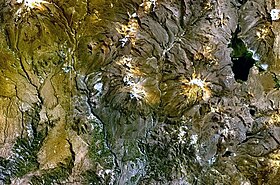Yukamani
| Yucamane | |
|---|---|
| Yucamani | |

Yucamane (center) and Lake Vilacota (on the right) as seen from above (NASA Landsat7 image)
|
|
| Highest point | |
| Elevation | 5,550 m (18,210 ft) |
| Coordinates | 17°11′0″S 70°12′0″W / 17.18333°S 70.20000°WCoordinates: 17°11′0″S 70°12′0″W / 17.18333°S 70.20000°W |
| Geography | |
| Location | Peru, Tacna Region |
| Geology | |
| Mountain type | Stratovolcanoes |
| Last eruption | June to November 1902 |
Yucamane or Yucamani is an andesitic stratovolcano group in southern Peru. It is in the Tacna Region, Candarave Province, Candarave District, west of lake Vilacota.
The group is mostly Holocene in age. During the Holocene, Yucamane has shown signs of Plinian eruptions which produced pyroclastic flows. The most recent of these events occurred around 1320 BC.
Yucamane is made up of two stratovolcanoes, Yucamane itself which rises to 5,550 m above sea level and Calientes which rises to 5,358 m above sea level. Only Yucamane has a youthful summit crater.
Potential historic eruptions were reported in 1787 and in the 19th and 20th centuries, but these are considered unlikely. The 1787 eruption was probably mistaken for the eruption of neighboring Tutupaca volcano.
...
Wikipedia

